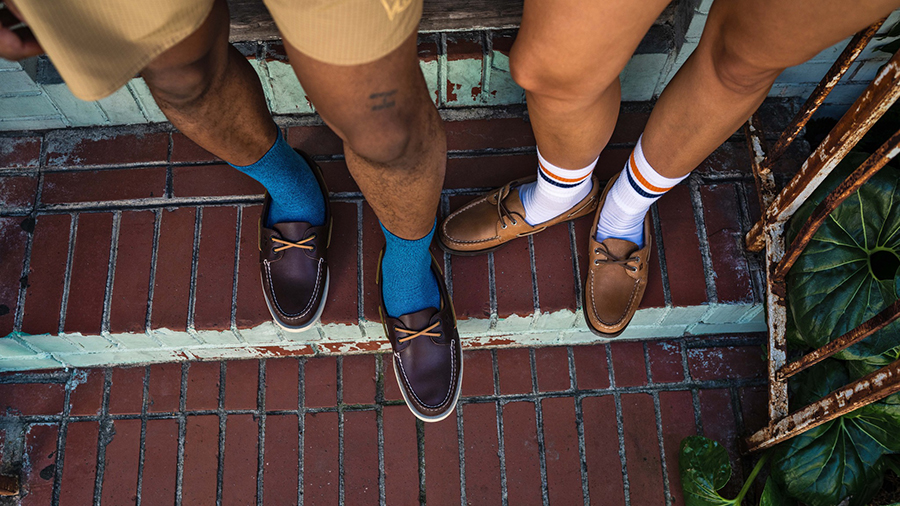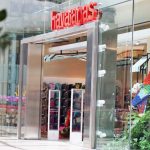Wolverine World Wide, Inc. reported first-quarter earnings that slightly exceeded expectations on strength at Merrell and Saucony while announcing that it was exploring the sale of its struggling Sperry business and revealing that Anne Cavassa, president of Saucony, had left the company.
Shares of Wolverine World Wide Inc. rose $1.71, or 11.3 percent, to $16.81 on the report which also saw Wolverine make progress in reducing inventories and reiterate its outlook for the year despite the challenging marketplace.
The potential Sperry sale comes as part of Wolverine’s Portfolio Optimization program first announced last December. So far, the program has seen Wolverine sell its Keds business and license its Hush Puppies brand to Designer Brands, the parent of DSW. Wolverine Leathers’ business also remains for sale.
On a call with analysts, Brendan Hoffman, president and CEO, said the Portfolio Optimization program enables Wolverine to focus its resources on businesses it believes will drive the highest return.
“As we evaluate opportunities ahead for the company, we need to focus our future efforts and investments on our growth brands, Merrell, Saucony and Sweaty Betty,” said Hoffman. “Therefore, we have decided to explore strategic alternatives for Sperry over the coming months while we continue the foundational work needed to position the brand for long-term success.”
He added, “It is the brand I was most familiar with when I joined the company. I’m convinced that with the right focus and investment, this brand has a very bright future. This decision will allow us to put more resources behind expanding Merrell’s lifestyle business; extending Saucony’s reach beyond the core to everyday active and lifestyle consumers; global expansion of Saucony’s Original business which remains robust in Europe and has great potential elsewhere in the world, particularly in the U.S.; stabilizing Sweaty Betty’s home market in the UK and Ireland while looking for opportunities globally, including the U.S. and China; and investing in technologies specifically around our e-commerce platform and user experience.”
The exit of Cavassa, who joined Saucony in 2018 as president from Brooks, comes despite Saucony delivering 25 percent growth on a currency-neutral basis in the first quarter.
Hoffman didn’t provide a reason on the analyst call for Cavassa’s exit. He said, “We thank her for her contributions and wish her well. The process of naming a successor is well underway. In the interim Chris Hufnagel, president of our Active Group, will be working more closely with our strong Saucony team. We believe having Chris more involved in the day-to-day operations at Saucony will allow for greater collaboration and synergies with Merrell as we look to solidify Saucony as a preeminent leader in core running and leverage the brand’s strength in technology and innovation to build out a lifestyle offering to broaden its wear occasions and consumer reach.”
Q1 Earnings Impacted By Margin Pressures
In the quarter ended April 1, sales declined 2.5 percent (-0.5 percent on a constant currency basis), to $599.4 million. Revenue from ongoing businesses reached $580.4 million, representing constant currency growth of 2.9 percent and landing just ahead of Wall Street’s consensus target of $577.5 million and in line with Wolverine’s expectations.
Ongoing sales exclude Keds and Wolverine Leathers and are adjusted for the transition of its Hush Puppies North America business to a licensing model in the second half of 2023.
The company’s international business was especially strong, up 12.6 percent or 18.0 percent on a constant currency basis to $249.7 million. Direct-to-consumer (DTC) revenue from the ongoing business was $124.9 million, down 7.7 percent on a reported basis and 4.4 percent on a constant currency basis.
Gross margin eroded 310 basis points to 39.4 percent, reflecting the sale of higher-cost inventory due to transitory supply chain costs from 2022, the acceleration of end-of-life inventory liquidation, and increased promotions.
SG&A expenses were $191.0 million, net of a $20.1 million gain on the divestiture of the Keds business. On an adjusted basis, SG&A expenses reached $202.7 million, or 34.9 percent of adjusted revenue, 45 basis points lower than the prior year.
Net income came to $18.0, or 23 cents a share, against earnings of $8.4 million, or 12 cents, a year ago. On an adjusted basis, non-GAAP EPS dropped 76.3 percent to 9 cents a share from 38 cents a year ago although ahead of analysts’ consensus estimate of 3 cents.
Q123 adjustments reflect the gain on the Keds divestiture and environmental and other related costs net of recoveries, partially offset by reorganization costs. Q1 2022 adjustments reflect environmental and other related costs net of recoveries.
Active Group’s Sales Boosted By Delivery Shift
Among its segments, sales in the Active Group (Merrell, Saucony, Sweaty Betty, Chaco) were up 11.5 percent (+15.0 percent on a currency-neutral basis) to $385.9 million.
Hoffman said Wolverine was “pleased” with the Active Group’s performance although some of the gains were due to timing given last year’s recovery from the Vietnam shutdown that is altering order flow throughout the first half of 2023. He said, “As expected, this benefited Q1 and will pressure Q2.”
Merrell Q1 Sales Jump 18 Percent
Merrell sales jumped 17.6 percent (+20.3 percent on a currency-neutral basis) to $180.3 million. Merrell’s performance was in line with expectations for high-teens growth in the quarter.
Hoffman said Merrell gained market share based on NPD data due to strength in core products and extensions in new franchises. Boosted by a strong response to the Moab 3, Merrell showed the biggest share gains of all brands in the hike category for the quarter. Trail running also returned to share gains in the first quarter.
“We are excited about Merrell’s expansion of its lifestyle product line and believe this is our highest growth opportunity for Merrell,” added Hoffman. Merrell’s 1TRL line continues to expand the brand’s reach with retail partners and customers. In the quarter, the first 1TRL store opened in Tokyo and more are planned.
Looking ahead, Merrell’s revenue is expected to grow mid-single-digits in fiscal 2023. Q2 revenues are expected to decline mid-teens versus 2022 caused both by the difficult macro-economic headwinds as well as the product-flow shifts. Merrell’s revenue is expected to be flat for the first half.
Saucony’s Q1 Sales Climb 21 Percent
Saucony’s sales climbed 21.2 percent (+24.5 percent on a currency-neutral basis) to $132.6 million. Revenue surpassed Wolverine’s expectations for high single-digit, driven by increases in the performance core run category and early progress on the brand’s initiative to broaden its reach to active and lifestyle consumers, along with the changing receipt flow.
In the quarter, the men’s Endorphin Elite was launched to a “very positive consumer reaction” and saw a 74 percent sell-through on Saucony.com in the first week of the launch. The Endorphin Elite also ranked among the top 10 most worn styles at the Boston Marathon and Saucony overall was the second-highest worn shoe brand in the sub-3-hour category at the race.
Saucony Originals business, which is approaching 20 percent of the brand’s global revenue, opened new wholesale accounts, including Shopbop, in the U.S. The launch of Saucony Originals’ DXN trainer backed by a ”Who is Rod Dixon” campaign led to the model landing on the number one spot for multiple weeks post-launch on Saucony’s European website. Looking ahead, Saucony’s revenues are projected to decline mid-single-digits in Q2, grow mid-single-digits in the first half and expand high-single-digits for the full year.
Sweaty Betty’s Sales Decline 3 Percent On A Currency-Neutral Basis
Sweaty Betty’s sales were off 11.4 percent (-3.1 percent on a currency-neutral basis) to $47.5 million. Hoffman said Sweaty Betty’s results were better than expectations for a mid-teens decline with the brand continuing to be impacted by a challenging retail environment in the UK. The recent launch of the Zero Gravity running bra along with other product innovations, has led to improved sales trends in April, higher units per transaction and less promotional activity. Wolverine acquired Sweaty Betty in August 2021.
“We continue to stabilize Sweaty Betty in its home market in the UK and Ireland while improving profitability through synergies from stronger integration within the rest of the portfolio,” said Hoffman.
Looking ahead, Sweaty Betty’s revenues are expected to decline in the low teens in the second quarter. For the year, the brand is expected to decline low-single digits on a reported basis but advance low-single digits on a constant-currency basis.
Work Group Sales Slide 17 Percent
Sales in the Work Group (Wolverine Brand, Cat, Bates, Harley-Davidson, HyTest) declined 17.3 percent (-17.3 percent on a currency-neutral basis) in the first quarter to $114.5 million. The revenue decline was primarily due to the normalized phasing of Cat’s international spring product flow as well as pressure from consumers trading down to lower price point products. The segment is seeing a strong response to increased under-$100 offerings.
Wolverine Brand’s sales were down 12.1 percent (-12.1 percent on a currency-neutral basis) to $51.7 million although it’s seeing a strong response in lifestyle offerings to collaborations. Bates plans to continue to test a launch at Walmart in over 200 stores in the second half of the year. Looking ahead, Work Group revenues are expected to be roughly flat in 2023, with high single-digit declines in Q2.
Sperry’s Q1 Sales Drop 13 Percent
Sales in the Lifestyle Group (Sperry, Hush Puppies) fell 21.1 percent (-20.9 percent on a currency-neutral basis) to $85.3 million. Sperry’s sales fell 13.0 percent (12.9 percent on a currency-neutral basis) to $62.9 million.
Sperry’s sales were softer than an expected high single-digit decline due to lower sell-throughs of certain styles caused in part by the unfavorable weather during the spring season. Said Hoffman, “We are focused on stabilizing Sperry with initiatives to introduce styles that more closely resemble the brand’s DNA. We remain optimistic about the growing prep fashion trend that is emerging in the market. We expect Sperry revenue to decline high single digits in fiscal 2023, with a low-teens decline in the second quarter.”
Operational Progress
Hoffman pointed to progress in improving operational capabilities, including the refinement of its operating structure, specifically a new brand group structure that now enables teams to more easily collaborate and share best practices across common categories and markets.
“We are also making great strides to modernize our supply chain and operations planning processes, including the investment in a new product life cycle management toolset that will be operational later this year,” said Hoffman.
He further said moves in March to integrate Sweaty Betty into Wolverine’s London-based international team are expected to help the brand better leverage the company’s logistics, technology and operational expertise to harvest savings that can be reinvested in growth opportunities for Sweaty Betty. The overall Profit Improvement Office plan remains on track to deliver $65 million of cost savings in 2023 with $150 million of annual savings expected in 2024.
Inventory at the end of the quarter was $725.9 million which excludes $11.2 million for held-for-sale business. Inventory was up 50.2 percent year over year but down approximately $19.0 million sequentially from the fourth quarter of 2022.
Outlook
Looking ahead, Hoffman said, “We are excited about newness and marketing initiatives planned for the back half of the year across our brands. We are fully on track to return to high single-digit growth in the second half of 2023 as we lap the supply chain disruptions of last year. Finally, we expect to continue to reduce inventory and take costs out of the business to free up investment for 2024 and beyond.”
Mike Stornant, EVP and CFO, said Wolverine is reiterating its guidance despite worsening conditions in the marketplace. He said, “Like many other companies in our industry, we have seen some deterioration in market trends since the start of the year and especially since early March. Macroeconomic concerns and a cold spring selling season have impacted consumer demand. Despite this added pressure, we believe the diversity of our portfolio and global reach will help to mitigate the risks ahead of us. As a result, we are reaffirming our outlook for revenue, earnings and year-end inventory.”
The guidance calls for:
- Revenue from its ongoing business is expected to be in the range of $2.53 billion to $2.58 billion, representing growth of approximately 0.0 percent to 2.0 percent and constant currency growth of approximately 1.0 percent to 3.0 percent;
- Gross margin is expected to be approximately 41.3 percent and adjusted gross margin is expected to be approximately 42.0 percent;
- Operating margin is expected to be approximately 8.7 percent, and adjusted operating margin is expected to be approximately 8.5 percent;
- The effective tax rate is expected to be approximately 21.0 percent;
- Diluted earnings per share are expected to be between $1.50 to $1.70 and adjusted diluted earnings per share are expected to be between $1.40 to $1.60. These full-year EPS expectations include an approximate $0.14 negative impact from foreign currency exchange rate fluctuations;
- Diluted weighted average shares are expected to be approximately 79.3 million; and
- Inventory is expected to improve by approximately $225 million by the end of the year.
Photo courtesy Sperry
















